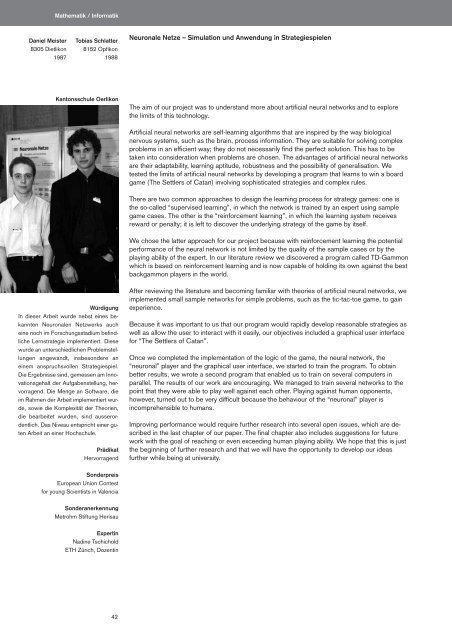SJf_Wettbewerbs_Broschüre_2007 - Die Goldene Sonne am Calanda
SJf_Wettbewerbs_Broschüre_2007 - Die Goldene Sonne am Calanda
SJf_Wettbewerbs_Broschüre_2007 - Die Goldene Sonne am Calanda
Sie wollen auch ein ePaper? Erhöhen Sie die Reichweite Ihrer Titel.
YUMPU macht aus Druck-PDFs automatisch weboptimierte ePaper, die Google liebt.
Daniel Meister<br />
8305 <strong>Die</strong>tlikon<br />
1987<br />
Mathematik / Informatik<br />
Tobias Schlatter<br />
8152 Opfikon<br />
1988<br />
Kantonsschule Oerlikon<br />
Würdigung<br />
In dieser Arbeit wurde nebst eines bekannten<br />
Neuronalen Netzwerks auch<br />
eine noch im Forschungsstadium befindliche<br />
Lernstrategie implementiert. <strong>Die</strong>se<br />
wurde an unterschiedlichen Problemstellungen<br />
angewandt, insbesondere an<br />
einem anspruchsvollen Strategiespiel.<br />
<strong>Die</strong> Ergebnisse sind, gemessen <strong>am</strong> Innovationsgehalt<br />
der Aufgabenstellung, hervorragend.<br />
<strong>Die</strong> Menge an Software, die<br />
im Rahmen der Arbeit implementiert wurde,<br />
sowie die Komplexität der Theorien,<br />
die bearbeitet wurden, sind ausserordentlich.<br />
Das Niveau entspricht einer guten<br />
Arbeit an einer Hochschule.<br />
Prädikat<br />
Hervorragend<br />
Sonderpreis<br />
European Union Contest<br />
for young Scientists in Valencia<br />
Sonderanerkennung<br />
Metrohm Stiftung Herisau<br />
Expertin<br />
Nadine Tschichold<br />
ETH Zürich, Dozentin<br />
42<br />
Neuronale Netze – Simulation und Anwendung in Strategiespielen<br />
The aim of our project was to understand more about artificial neural networks and to explore<br />
the limits of this technology.<br />
Artificial neural networks are self-learning algorithms that are inspired by the way biological<br />
nervous systems, such as the brain, process information. They are suitable for solving complex<br />
problems in an efficient way; they do not necessarily find the perfect solution. This has to be<br />
taken into consideration when problems are chosen. The advantages of artificial neural networks<br />
are their adaptability, learning aptitude, robustness and the possibility of generalisation. We<br />
tested the limits of artificial neural networks by developing a progr<strong>am</strong> that learns to win a board<br />
g<strong>am</strong>e (The Settlers of Catan) involving sophisticated strategies and complex rules.<br />
There are two common approaches to design the learning process for strategy g<strong>am</strong>es: one is<br />
the so-called “supervised learning”, in which the network is trained by an expert using s<strong>am</strong>ple<br />
g<strong>am</strong>e cases. The other is the “reinforcement learning”, in which the learning system receives<br />
reward or penalty; it is left to discover the underlying strategy of the g<strong>am</strong>e by itself.<br />
We chose the latter approach for our project because with reinforcement learning the potential<br />
performance of the neural network is not limited by the quality of the s<strong>am</strong>ple cases or by the<br />
playing ability of the expert. In our literature review we discovered a progr<strong>am</strong> called TD-G<strong>am</strong>mon<br />
which is based on reinforcement learning and is now capable of holding its own against the best<br />
backg<strong>am</strong>mon players in the world.<br />
After reviewing the literature and becoming f<strong>am</strong>iliar with theories of artificial neural networks, we<br />
implemented small s<strong>am</strong>ple networks for simple problems, such as the tic-tac-toe g<strong>am</strong>e, to gain<br />
experience.<br />
Because it was important to us that our progr<strong>am</strong> would rapidly develop reasonable strategies as<br />
well as allow the user to interact with it easily, our objectives included a graphical user interface<br />
for “The Settlers of Catan”.<br />
Once we completed the implementation of the logic of the g<strong>am</strong>e, the neural network, the<br />
“neuronal” player and the graphical user interface, we started to train the progr<strong>am</strong>. To obtain<br />
better results, we wrote a second progr<strong>am</strong> that enabled us to train on several computers in<br />
parallel. The results of our work are encouraging. We managed to train several networks to the<br />
point that they were able to play well against each other. Playing against human opponents,<br />
however, turned out to be very difficult because the behaviour of the “neuronal” player is<br />
incomprehensible to humans.<br />
Improving performance would require further research into several open issues, which are described<br />
in the last chapter of our paper. The final chapter also includes suggestions for future<br />
work with the goal of reaching or even exceeding human playing ability. We hope that this is just<br />
the beginning of further research and that we will have the opportunity to develop our ideas<br />
further while being at university.


